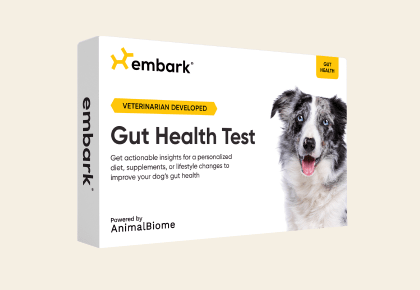The Embark Age Test uses a dog’s DNA to estimate their calendar age. Specifically, it uses a type of epigenetic marker called DNA methylation.
There are several physical clues that veterinarians use to estimate dog age, including body shape and lens clarity. Teeth can also indicate a dog’s age, although not all dogs follow the same progression from puppy teeth to adult teeth, and age is harder to determine after puppyhood.
Age can be notoriously difficult to judge in dogs based on visual cues alone. That’s why we use the scientific field of epigenetics to estimate your dog’s age based on their DNA.
“Studies have shown age determination based on physical exam findings in adult dogs (including eye clarity, dental tartar, and tooth wear) does not yield a highly accurate result, despite pet care professionals’ best efforts with available parameters. This is especially true in dogs with unknown histories, like many shelter rescues. DNA methylation offers an additional method for estimating age that veterinarians may now use in conjunction with traditional measures. Additionally, this technology may help pave the way for future discovery in dogs.”
— Jenna Dockweiler, MS, DVM, DACT, CCRT, CVAT, Veterinary Geneticist at Embark
Here, we’ll explain how the Embark Age Test works.
What is epigenetics?
If you’ve used a dog DNA test, you’re probably familiar with genetics—the study of DNA. Epigenetics is a related field that looks at factors that interact with DNA.
According to the Centers for Disease Control and Prevention:
“Epigenetics is the study of how your behaviors and environment can cause changes that affect the way your genes work. Unlike genetic changes, epigenetic changes are reversible and do not change your DNA sequence, but they can change how your body reads a DNA sequence.”
Epigenetic patterns can change with environment, lifestyle, stress, disease, or age.
There are many kinds of epigenetic markers that can affect DNA. The Embark Age Test uses one type of epigenetic marker, called DNA methylation, to predict a dog’s age.
What is DNA methylation?
DNA methylation is the most well-known type of epigenetic marker. Research on epigenetics has been going on for decades, and scientists have studied DNA methylation specifically for much of that time. In fact, DNA methylation is one of the most well-understood epigenetic mechanisms that regulates gene expression in a cell (Arneson et al. 2022). Methylation doesn’t change the actual genetic code, but it changes how that code is expressed.
Methylation refers to a molecular group (one carbon atom and three hydrogen atoms, represented in yellow below) that can be attached to a DNA strand. They can be added or removed over time.

In the past 10 years, scientists have begun analyzing DNA methylation to estimate age. Studying the relationship between methylation and age is a cutting-edge area of science. There are published papers showing this method works in dogs, humans, and many other mammals.
As dogs age, the level of DNA methylation changes in a predictable way. Overall, methylation decreases with age (Field et al. 2018; Horvath 2013), although there are some sites where it increases. We can use the amount and position of DNA methylation as a type of “clock” to estimate how old your dog is (Horvath et al. 2022).
How does the Embark Age Test work?
The Age Test measures the amount of methylation across thousands of markers in a dog’s genome. Our Age Test model allows us to predict a dog’s age based on that methylation profile.
The Age Test estimates your dog’s age within a range of time called a prediction interval. The estimated birthday in your dog’s results is the midpoint of that age range. When you purchase the Age Test, you’ll receive an estimated age and birthdate for your dog, as well as information about the prediction interval.
The Age Test relies on the trusted microarray technology used by our other tests (such as Breed ID and Breed + Health), but it requires a special processing step to measure methylation. That extra step means we can’t use the same DNA across a Breed + Health Test and an Age Test. Each test is run separately and requires its own swab.
How accurate is the Embark Age Test?
We developed our Age Test algorithm using DNA methylation data from thousands of dogs, then used that algorithm to predict the ages for a different set of dogs with known ages. We then used that independent set of dogs to measure how different our algorithm’s predictions are from the dogs’ true ages. That difference then provides the prediction interval that assesses the accuracy of our model.
The interval tells you the range of dates that are likely to contain your dog’s true birthday. The birthday reported in your dog’s results is an estimated birthday that is in the middle of this interval.
With the Age Test, 77% of dogs have a true birthday within 12 months of their estimated birthday.
Here’s an example Age Test result:

In this example, Ducky’s estimated age based on his DNA methylation is 3 years, 10 months.
If we ran Ducky’s DNA on the Age Test 100 times, we would expect that in 77 of those 100 tests, his estimated age would be between 2 years, 10 months and 4 years, 10 months—the prediction interval. In the 10 remaining tests, we’d expect that his results could be outside this date range.
This means that if one dog takes the Age Test multiple times, they may receive different estimated birthdays, but we expect 77% to fall within the same prediction interval in the test results.
We also tested the model coverage for different intervals, using an independent set of dogs with known ages. In these tests, we found that the Age Test predicted 90% of dogs’ ages within 18 months and 95% of dogs’ ages within 22 months.
Why an estimated birthday? We heard feedback from our customers and fellow dog lovers who want to know when to celebrate their dog’s special day. We hope that knowing their estimated birthday gives you another great reason to celebrate your dog and everything that makes them unique.
Although it does not pinpoint the exact date of your dog’s birth, the Age Test is comparable to the most accurate methylation clock models available today. It also follows scientific best practices for measuring the accuracy of the type of model we used for the Age Test.
How did Embark develop the Age Test?
To develop the Age Test, we took these steps:
- Developed a carefully curated reference data set
To develop our reference set, we collected DNA from 2,000+ dogs and analyzed their methylation data. The dogs in this reference data set represented a wide range of known ages and body sizes. - Performed quality control
To prevent bias in our model, we performed quality control steps and included only the data that passed quality control in our reference data set. This is the data set we used to train the model. This step helped to ensure the quality of Age Test results. - Validated model options
Previous methylation studies by other researchers have used a variety of statistical frameworks to model how age relates to methylation. We validated these models both internally and externally, with help from scientists at Embark as well as other experts in the field. - Checked a final time
We evaluated how well the models perform using an independent set of dogs that had not been tested yet or involved in developing the model. - Selected the best model
After exploring and testing these different types of models, we selected the most robust model for the Age Test. That’s the model we use today. - Reproduced the results
Finally, we independently reproduced each step of the final model to make sure it is accurate and reliable.
Predicting age using DNA methylation patterns is an exciting area of science. As more dogs are added to our database by new Age Test customers, we’ll continue to refine our model.
Caring for your dog at every age
Learn more about the different dog life stages and health considerations to keep in mind as your dog celebrates more birthdays. Consider trying a daily supplement to support their health and help them feel their best all year long.











